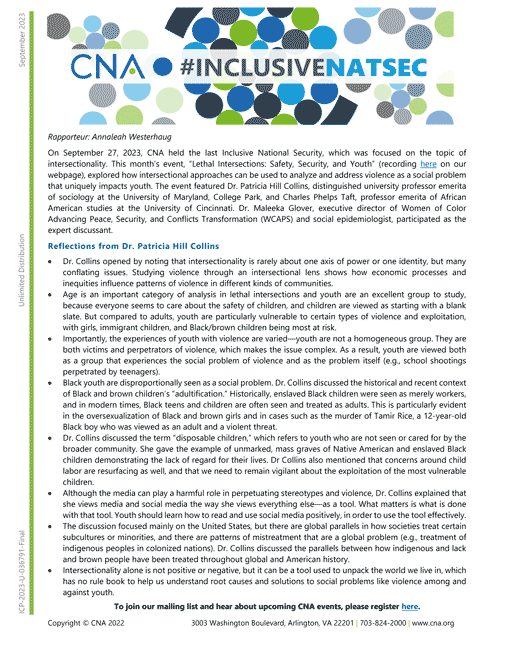Inclusive NatSec September 27, 2023
On September 27, 2023, CNA held the last Inclusive National Security, which was focused on the topic of intersectionality. This month’s event, “Lethal Intersections: Safety, Security, and Youth” (recording here on our webpage), explored how intersectional approaches can be used to analyze and address violence as a social problem that uniquely impacts youth. The event featured Dr. Patricia Hill Collins, distinguished university professor emerita of sociology at the University of Maryland, College Park, and Charles Phelps Taft, professor emerita of African American studies at the University of Cincinnati. Dr. Maleeka Glover, executive director of Women of Color Advancing Peace, Security, and Conflicts Transformation (WCAPS) and social epidemiologist, participated as the expert discussant.
Reflections from Dr. Patricia Hill Collins
- Dr. Collins opened by noting that intersectionality is rarely about one axis of power or one identity, but manyconflating issues. Studying violence through an intersectional lens shows how economic processes andinequities influence patterns of violence in different kinds of communities.
- Age is an important category of analysis in lethal intersections and youth are an excellent group to study,because everyone seems to care about the safety of children, and children are viewed as starting with a blankslate. But compared to adults, youth are particularly vulnerable to certain types of violence and exploitation,with girls, immigrant children, and Black/brown children being most at risk.
- Importantly, the experiences of youth with violence are varied—youth are not a homogeneous group. They areboth victims and perpetrators of violence, which makes the issue complex. As a result, youth are viewed bothas a group that experiences the social problem of violence and as the problem itself (e.g., school shootingsperpetrated by teenagers).
- Black youth are disproportionally seen as a social problem. Dr. Collins discussed the historical and recent contextof Black and brown children’s “adultification.” Historically, enslaved Black children were seen as merely workers,and in modern times, Black teens and children are often seen and treated as adults. This is particularly evidentin the oversexualization of Black and brown girls and in cases such as the murder of Tamir Rice, a 12-year-oldBlack boy who was viewed as an adult and a violent threat.
- Dr. Collins discussed the term “disposable children,” which refers to youth who are not seen or cared for by thebroader community. She gave the example of unmarked, mass graves of Native American and enslaved Blackchildren demonstrating the lack of regard for their lives. Dr Collins also mentioned that concerns around childlabor are resurfacing as well, and that we need to remain vigilant about the exploitation of the most vulnerablechildren.
- Although the media can play a harmful role in perpetuating stereotypes and violence, Dr. Collins explained thatshe views media and social media the way she views everything else—as a tool. What matters is what is donewith that tool. Youth should learn how to read and use social media positively, in order to use the tool effectively.
- The discussion focused mainly on the United States, but there are global parallels in how societies treat certainsubcultures or minorities, and there are patterns of mistreatment that are a global problem (e.g., treatment ofindigenous peoples in colonized nations). Dr. Collins discussed the parallels between how indigenous and lackand brown people have been treated throughout global and American history.
- Intersectionality alone is not positive or negative, but it can be a tool used to unpack the world we live in, whichhas no rule book to help us understand root causes and solutions to social problems like violence among andagainst youth.
Unlimited Distribution
Details
- Pages: 1
- Document Number: ICP-2023-U-036791-Final
- Publication Date: 9/29/2023
